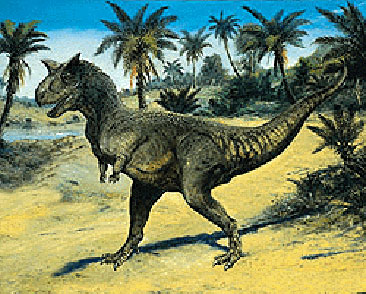Carnotaurus Sastrei See map
El Toro Carnivore (Carnotaurus) was one of the fearsome predators of the Cretaceous period. The bones of this animal were located in the fields of a rancher named Sastre who ended up giving his last name to this creature that walked its ten meters long by what is now known as the Pampa de Gastre, in the province of Chubut.
The estimated age of this animal is 95 million years, dating from the Early Cretaceous that located near the Giganotosaurus Carolinii, not to mention about a thousand kilometerss of distance separating the two findings.
 Carnotaurus Sastrei.
Carnotaurus Sastrei.The most striking aspect of this carnivorous bull are its spectacular horns that served to attack its victims and rivals. Its extremely small arms had an advanced state of atrophy and were-even-smaller than the ones of the Tyrannosaurus Rex. It is estimated that his power strenght was sustained in a powerful jaw with sharp teeth and in his horns.
The snout of the Carnotaurus had ridges and prominences suggesting that his skin was rough and thick. It is believed that the roughness of the dorsal area of the head served as a protection to the animal each time it introduced its nose into the bodies of their victims. The animal, found in the place Bajada Moreno, fed especially of sauropods related to the Chubutisaurus, the Limaysaurus and the Andesaurus.
Carnotaurus fossils are on display at the Museum of Natural Sciences in Buenos Aires and at the Museum Egidio Feruglio of Trelew.
In January 1999, a team led by paleontologists Rodolfo Coria (Carmen Funes Museum in Plaza Huincul), and Luis Chiappe (Museum of Los Angeles), found in the area surrounding the volcano Auca Mahuida (about 120 kilometers from the city Neuquén) the bones of what would later be presented as the first Carnotaurus of the Upper Valley of Negro River.
Subsequent studies suggest that Auca Mahuida creature -a carnivore that in life measured eight meters long- is of a different species but with many similarities to the Carnotaurus. Of the dinosaur of Neuquén were found 90 percent of the bones, which in these days are been studied in the Carmen Funes Museum.
The discovery was made as part of the expedition to rescue the sauropod eggs lying near the dead volcano.
Viajes por la Patagonia
Related Articles
© Patagonia.com.ar 2025 | Todos los derechos reservados.
